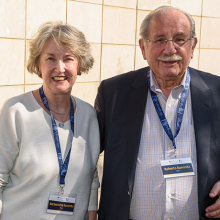Lift off
NASA to partner with Weizmann on ULTRASAT space telescope
Briefs

The US National Aeronautics and Space Administration is set to launch Israel’s first space telescope—the Ultraviolet Transient Astronomy Satellite, orULTRASAT, designed by Weizmann astrophysicists—into high-Earth orbit in early 2026.
NASA’s involvement was madeofficial through a new partnership with the Israel Space Agency. Under the agreement, signed in February 2023, NASA will support the launch of ULTRASAT from the Kennedy Space Center at Cape Canaveral, Florida, and will become an active partner in the ULTRASAT science program, with NASA investigators slated to join ULTRASAT working groups headed by Weizmann scientists.
The space telescope is expected to revolutionize scientists’ ability to detect and analyze transient events in the Universe, such as neutron star mergers and supernova explosions. Surveying space with an unprecedentedly wide field of view, ULTRASAT will capture evidence of fast-emerging, cataclysmic events, such as the formation of black holes—wherever they may be allowing scientists to detect UV electromagnetic radiation from deep space and decode hidden messages from the hottest, most action-packed parts of the Universe.
The agreement follows a meeting on the Weizmann campus in December 2022, between the ULTRASAT leadership team, chaired by Prof. Eli Waxman of the Department of Particle Physics and Astrophysics, and a NASA delegation headed by Dr. Mark Clampin, Director of NASA’s Astrophysics Division. Dr. Clampin also served as Project Scientist for the James Webb Space Telescope. The December meeting was followed by a January 2023 visit of a large delegation led by NASA’s Associate Administrator Robert Cabana.
“We are proud to join this partnership, an international effort that will help us better understand the mysteries of the hot, transient universe,” Dr. Clampin said in a press release. “ULTRASAT will give the global science community another important capability for making new observations relevant to emerging areas of astrophysics.”
“This is a breakthrough project that places Israel at the forefront of global research,” Prof. Waxman added. “Leading international bodies such as NASA and the DESY research institute [in Germany] have joined this Israeli-led project as partners, having recognized its scientific significance. They are investing considerable resources in the construction and launch of the satellite to become active participants in this mission with access to its scientific products. It’s a science-driven partnership.”








